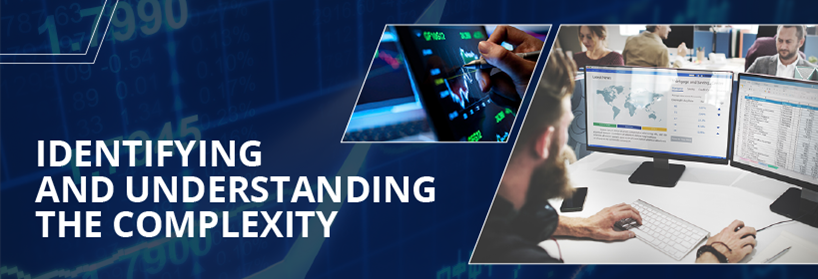Home » Blog » Trading & Risk Management » Identifying and Understanding Complexity in Measuring an Energy Utility Enterprise’s Financial Risk Pt. 1
Identifying and Understanding Complexity in Measuring an Energy Utility Enterprise’s Financial Risk Pt. 1
The Problem and Why It Matters
An energy utility’s executive management and board want to know the risks to the utility’s bottom line financial performance over a budget period, in order to, among other things, 1) assess ability or readiness to meet liquidity requirements caused by market and credit events, and 2) assess the viability of planned strategic initiatives like debt capacity management and asset expansion.
At the same time, there is an interest to provide credible financial risk guidance to the capital markets and possibly garner more favorable company valuation. For the purposes of this blog, this particular energy utility engages in asset operations in the bulk power or Day 2 markets, trading activities in support of core operations, and structuring and contracting long-term marketing agreements.
Quantifying financial risk in the midst of constant change with routine operational activities complicates prospective cash flow forecasting. Many concerned observers may be curious — what type of financial risk assessment is appropriate for these situations and gives energy utilities a fighting chance to effectively measure and manage their corporate financial objectives? And how can this be done in a timely, cost-effective, and less complicated fashion?
Meaningful measurement of enterprise financial risk for any business entity is fraught with challenges. Risk measurement must be conducted under normal conditions as well as a range of stress scenarios. All this begs for a tractable, analytical framework. Enterprise financial risk measures are of the ‘at-risk’ type such as revenue-at-risk, cost-at-risk, cash flow-at-risk, and earnings-at-risk. By “meaningful,” I mean risk measures that are credible — and to be credible, the risk measures must encompass the entire business footprint of the energy utility or market participant. For most energy utilities, obtaining such enterprise-wide risk measures require that the analytical tool employed to carry out the analysis must accommodate simultaneous coverage of asset operations, trading activities, and structuring of off-balance-sheet commitments.
Other material considerations come into play when choosing the analytical framework that best suits the business circumstances of an energy utility. Regional Transmission Organization (RTO) market operations create market risks around utility revenue and cost drivers which impact prospective cash flows for market participants. Knowing this, uncertainty surrounds dispatched energy, load served, and cleared LMP prices which then impact, for better or worse, utility revenues, cost, cash flow, and earnings. This is further compounded when we consider financial outcomes originating from trading activities that support the core businesses and the obligations tied to the performance of bilateral long-term marketing agreements.
Common Practice
All too often the estimation of firm-wide risk for asset-rich energy utilities focuses exclusively on generation and load activities. In other words, only the utility’s asset operations are considered while the utility’s other activities referenced above are conveniently ignored. Under this framework, the calculation engines rely on complex dynamic programming of economic dispatch models that emphasize, appropriately I might add, the capture of generator physical constraints, and transmission bottlenecks in serving load. This works quite well for Day 1 markets, where utilities control the transmission network. Day 2 markets, where transmission is controlled and managed by the RTO, are an entirely different matter.
In Day 2 markets, complexity rules the day due to the nature of the supply stack optimization problem that encompasses all generators offered in the market space. This, I admit, is nearly impossible for a single energy utility to accurately model to produce instant trustworthy strategic insights at the enterprise level. All things considered, even from the asset side of the enterprise equation, it simply may not have access to the breadth and depth of needed competitor data that the RTO collects as part of its market design.
So what should one do? Is there an effective way to bypass this complexity, while still being able to produce a credible and holistic assessment of the utility’s financial performance and risk?
Stay tuned for my follow-up blog — I’ll address these questions and more.
About Author
Mr. Geoff Anato-Mensah has over 35 years of corporate business experience, with the last fifteen focused on energy risk management. Mr. Anato-Mensah is currently Managing Director of Risk at Open Access Technology International, Inc. (OATI). He has directed, managed, and implemented financial valuation and risk management programs for energy companies. He has strong quantitative skills in asset valuation, credit risk modeling, market risk modeling, derivatives pricing, options trading, strategic planning, and risk policy development. He has been certified as an Energy Risk Professional (ERP) by the Global Association of Risk Professionals (GARP) following successful completion of a rigorous energy risk management program.
In his current role, Mr. Anato-Mensah is leading the vision for the OATI risk solution for energy Market Participants. In previous managerial risk roles, he developed and directed risk management programs covering risk identification, risk assessment, risk limit setting, risk monitoring, risk mitigation, and risk reporting to company stakeholders.
- March 19, 2018
